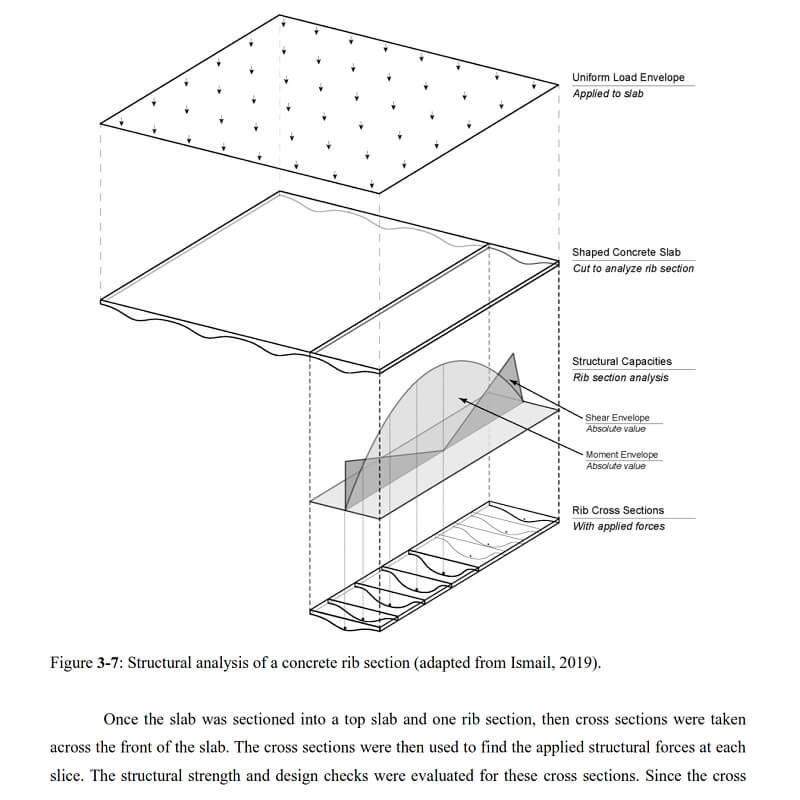Structural Acoustic Optimization
STRUCTURAL-ACOUSTIC OPTIMIZATION OF SHAPED CONCRETE FLOORS IN BUILDINGS
Jonathan Michael Broyles
In Partial Fulfillment of the Requirements for the Degree of Master of Science in Architectural Engineering
August 2020

With advancements in design tools, architects and engineers have developed novel sustainable solutions that reduce the amount of embodied carbon in structures while maintaining structural integrity. A concrete structural system, though commonly used, contributes a large portion of a building’s overall weight, emissions, and embodied carbon.
 Concrete systems are often overdesigned in terms of material when using common construction and fabrication practices, resulting in a larger building embodied carbon footprint than necessary. As advanced construction technology and fabrication methods have emerged alongside performance-based design methods, new design possibilities can be found through computational methods such as structural optimization.
Concrete systems are often overdesigned in terms of material when using common construction and fabrication practices, resulting in a larger building embodied carbon footprint than necessary. As advanced construction technology and fabrication methods have emerged alongside performance-based design methods, new design possibilities can be found through computational methods such as structural optimization.
 However, structural optimization procedures often neglect secondary design objectives such as acoustics during the computational process. Acoustic-based performance objectives are directly impacted by structural shaping due to the overlap of objectives such as structural mass, which relates to sustainability. Sound phenomenon such as speech can be easily transmitted through lighter, thinner elements compared to heavier, stiffer elements.
However, structural optimization procedures often neglect secondary design objectives such as acoustics during the computational process. Acoustic-based performance objectives are directly impacted by structural shaping due to the overlap of objectives such as structural mass, which relates to sustainability. Sound phenomenon such as speech can be easily transmitted through lighter, thinner elements compared to heavier, stiffer elements.
 The acoustic characteristic of transmission loss, which describes the amount of sound transmitted through a structure, is a concern while shaping concrete slabs, as geometry-based structural optimization may create an unsatisfactory acoustic environment between building floors. The acoustic metric, sound transmission class (STC), is used to provide a single number quantity to represent the transmission loss values in one-third octave bands.
The acoustic characteristic of transmission loss, which describes the amount of sound transmitted through a structure, is a concern while shaping concrete slabs, as geometry-based structural optimization may create an unsatisfactory acoustic environment between building floors. The acoustic metric, sound transmission class (STC), is used to provide a single number quantity to represent the transmission loss values in one-third octave bands.
 This thesis by Jonathan Michael Broyles, performs an investigation of structural and acoustic behavior for shaped concrete slabs with curved, non-standard geometry. Nine unique geometric variables were used to define and shape concrete slabs. For this parametric geometry, structural and acoustic models were developed to simultaneously evaluate each design as geometric variables changed.
This thesis by Jonathan Michael Broyles, performs an investigation of structural and acoustic behavior for shaped concrete slabs with curved, non-standard geometry. Nine unique geometric variables were used to define and shape concrete slabs. For this parametric geometry, structural and acoustic models were developed to simultaneously evaluate each design as geometric variables changed.
 The design space was sampled using Latin Hypercube Sampling (LHS) to determine broad relationships between structural mass and STC. Structural mass is the objective that relates to embodied carbon; as structural mass decreases, the amount of embodied carbon the slab has decreases. STC is a standard metric that quantifies acoustic performance of speech and noise transmission through a structure.
The design space was sampled using Latin Hypercube Sampling (LHS) to determine broad relationships between structural mass and STC. Structural mass is the objective that relates to embodied carbon; as structural mass decreases, the amount of embodied carbon the slab has decreases. STC is a standard metric that quantifies acoustic performance of speech and noise transmission through a structure.
 The structural model and acoustic model identify slab designs that meet all the structural and acoustic checks. Following initial design space exploration, multi-objective optimization (MOO) was used to improve upon the resolution of obtaining the best shaped slabs in the design space while confirming the general structural-acoustic trends from LHS.
The structural model and acoustic model identify slab designs that meet all the structural and acoustic checks. Following initial design space exploration, multi-objective optimization (MOO) was used to improve upon the resolution of obtaining the best shaped slabs in the design space while confirming the general structural-acoustic trends from LHS.
 Then constrained optimization was used to find the best performing shaped slab designs at specific acoustic levels. Constrained optimization further increased the resolution of obtaining the best shaped slabs from MOO. The benefits of shaped concrete slabs were then compared to conventional layered floor constructions.
Then constrained optimization was used to find the best performing shaped slab designs at specific acoustic levels. Constrained optimization further increased the resolution of obtaining the best shaped slabs from MOO. The benefits of shaped concrete slabs were then compared to conventional layered floor constructions.






























Comments